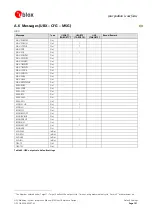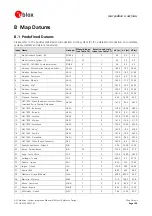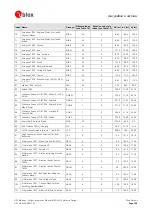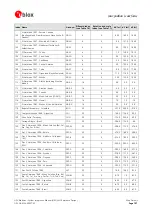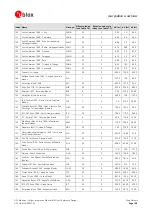
your position is our focus
8 Troubleshooting
The ANTARI
®
GPS receiver does not
F
ati
M
ur
antenna
has
a
g
sky
view.
bstructed
view
leads
to
prolonge
startup
times.
In
igned
system,
the
a
of
the C/No
ratio
high
eleva
satellites
should
be
in
the
range
of
4
o
about
50
dBHz.
Wit
standard
ff-the-shelf ctive
antenna,
47
dBHz
should
easily
be
achieved.
L
values
lead
to
a
prolon
startup
time.
The position drifts heavily
M
r
antenna
has
a
g
sky
view.
ucted
v
leads
to
tion rift.
Check
the
current
satellite
c
fore
starting
st
tests
in
er
to
make
sure
it
matches
e
test
specifications
(typically
H
Check
every
test
dr
r
critical positions
(minimal
number
of
SV in
view)
and
monitor
the
DOP
(
If
using
UBX
protoc
on’t
forge
to
check
th position
accuracy
estimation.
The position is off by a few dozen meters
T
IS
GPS
Technology
s
differ nt
datums.
default,
it
arts
up with
the
WGS84
standard
GPS
d
your
application
expe
different datum,
you’ll
most
likely find
the
positions
to
be
off
by
a
few
d
rs.
Find
out
what
kin
datum
your
applicatio
requires
an
config re
the
EvalKit
accordingly.
And
d
get
to
check
the
calibration
of
u-cen r
AE
map
files.
The position is off by hundreds of meters
P
may
also
occur
wh
lmanac
navigation
is
bled.
The
tellite
rbit
information
retrieved
from
an
c
is
much
less
accura
an
the
information
re eved
from the
ephemeris.
With
an
almanac
only
s
e
sition
will
only
h
accura
of
a
few
kilometers
but
may
artup
faster
or
still
navigate
in
a
scured
visibility
wh
e
ephem ris
from
on or
several
satellites
ave
not
yet
been
received.
The
a
rmation
is
NOT
use
calculati g
a
position if
valid
ephe eris
in rmation
is
present,
regardless
o
of
this
flag.
In
tocol,
position
sol
s
with
high
deviatio
.g.
due
to enabli
almanac
navigation)
can
be
f
the
Position
Accura
ask.
UBX
tocol
doe
not
directly
port this
since
it
provides
a
position
a
mation,
which
allo
user
t
filter
the
p ition
according
to
is
requirements.
However,
the
‘
within
Limits’
flag
of
th
-NAV-S ATUS
messa e
indicate
whether
e
configured
thresholds
(i.e.
P
Accuracy
Mask
and
PDOP)
are
ex
d.
The ANTARIS
®
GPS does not preserve the configuration in case of a reset
Th
ARIS
®
GPS
technology
uses a
slightly
different
concept
than
most
of
the
her
GPS
receivers
do.
Settings
y.
In
order
to
save
them
permanently,
sending
a
second
command
is
required.
This
allows
testing
the
new
settings
and
reverting
to
the
old
settings
by
resetting
the
receiver
if
the
new
settings
are
no
good.
This
is
some
kind
of
a
safety
procedure
as
it's
no
longer
possible
to
accidentally
program
a
bad
configuration
(e.g.
disabling
the
main
communication
port).
See
Section 4.9.2
for
the
details.
On my GPS receiver with external power management, the Hotstart TTFF times are much longer than
specified
On
startup
(after
the
first
position
fix)
the
GPS
receiver
performs
a
RTC
calibration
to
have
an
accurate
internal
time
source.
A
calibrated
RTC
is
required
to
achieve
minimal
startup
time.
Before
shutting
down
the
receiver
externally,
check
the
status
in
MON-HW
in
field
‘Real
Time
Clock
Status’.
Don’t
shut
down
the
receiver
if
the
RTC
is
not
calibrated.
S
meet the TT F specific
on
ake
sure
yo
ood
O
d
a
well es
-d
4
dBHz t
verage
of
tion
ow
C/No
h
a
o
a
ged
ake
sure
you
ood
Obstr
iew
posi
d
onstellation
be
atic
ord
th
DOP<2.0).
ive
fo
e.g.
HDOP).
ol,
d
t
e
®
upports
e
By
st
he
ANTAR
atum.
If
cts
a
ozen
mete
d
of
n
d
u
o
not
for
te
osition drift
an
en
a
ena
sa
o
alm
a
olution
th
te
th
ave
an
tri
it
po
reas
with
b
cy
st
o
lmanac
inf
en
th
e
e
h
o
f
the
setting
d
for
n
,
m
fo
NMEA
pro
ution
n
(e
ng
iltered
with
cy
M
pro
s
sup
ws
the
o
os
h
ccuracy
esti
Position
e
UBX
T
g
th
ceede
ot
e
ANT
are
initially
stored
to
volatile
memor
GPS
Modules
-
System
Integration
Manual
(SIM)
(incl.
Reference
Design)
Troubleshooting
GPS.G4-MS4-05007-A1
Page 144






















